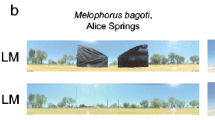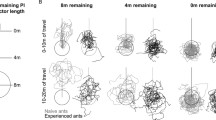Abstract
In the habitat of desert ants, Cataglyphis fortis, a constant wind is usually blowing during the daytime. When visiting a familiar food source, the ants steer some distance downwind of the feeder, rather than attempting a direct approach that might miss small food sources, in particular. In the downwind area, the ants pick up the odor plume emanating from the food and follow it upwind to the prey. This strategy saves considerable walking distance and time. The additional path necessitated by the downwind strategy is only about 0.75 to 2 m, depending on nest–feeder distance, while missing the food on the upwind side results in much longer search trajectories. During the initial three to five visits to a feeding site, downwind distance and length of the approach path are shortened notably, and the approach trajectory is straightened. Desert ants further exhibit considerable short-term flexibility in their approach. Experienced individuals are evidently able to decide upon leaving the nest which direction to choose toward the feeder, depending on current wind direction (that fluctuates slightly during the day). Notable changes in wind direction occur primarily overnight. For larger nest–feeder distances, the animals adjust their approach en route to the altered wind direction during their first foraging trip in the morning.






Similar content being viewed by others
References
Batschelet E (1981) Circular statistics in biology. Academic, New York
Bisch-Knaden S, Wehner R (2003) Landmark memories are more robust when acquired at the nest site than en route: experiments in desert ants. Naturwissenschaften 90:127–130
Cheng K, Srinivasan MV, Zhang SW (1999) Error is proportional to distance measured by honey bees: Weber’s law in the odometer. Anim Cogn 2:11–16
Cheng K, Narendra A, Wehner R (2006) Behavioral ecology of odometric memories in desert ants: acquisition, retention, and integration. Behav Ecol 17:227–235
Collett M, Collett TS, Wehner R (1999) Calibration of vector navigation in desert ants. Curr Biol 9:1031–1034
Collett TS, Graham P, Durier V (2003) Route learning by insects. Curr Opin Neurobiol 13:718–725
Etienne AS, Maurer R, Berlie J, Reverdin B, Rowe T, Georgakopoulos J, Séguinot V (1998) Navigation through vector addition. Nature 396:161–164
Forel A (1902) Beispiele phylogenetischer Wirkungen und Rückwirkungen bei den Instinkten und dem Körperbau der Ameisen als Belege für die Evolutionslehre und die psychophysische Identitätslehre. J Psychol Neurol 1:99–110
Fresneau D (1985) Individual foraging and path fidelity in a ponerine ant. Ins Soc 32:109–116
Harrison JF, Fewell JH, Stiller TM, Breed MD (1989) Effects of experience on use of orientation cues in the giant tropical ant. Anim Behav 37:869–871
Lehrer M (1993) Why do bees turn back and look? J Comp Physiol A 172:549–563
Merkle T, Knaden M, Wehner R (2006) Uncertainty about nest position influences systematic search strategies in desert ants. J Exp Biol 209:3545–3549
Müller M, Wehner R (1988) Path integration in desert ants, Cataglyphis fortis. Proc Natl Acad Sci USA 85:5287–5290
Narendra A, Cheng K, Wehner R (2007) Acquiring, retaining and integrating memories of the outbound distance in the Australian desert ant Melophorus bagoti. J Exp Biol 210:570–577
Nicholson DJ, Judd SPD, Cartwright BA, Collett TS (1999) Learning walks and landmark guidance in wood ants (Formica rufa). J Exp Biol 202:1831–1838
Sachs L (1992) Angewandte Statistik. Springer, Berlin
Schmid-Hempel P (1983) Foraging ecology and colony structure of two sympatric species of desert ants, Cataglyphis bicolor and Cataglyphis albicans. Dissertation, Universität Zürich
Seidl T, Wehner R (2006) Visual and tactile learning of ground structures in desert ants. J Exp Biol 209:3336–3344
Sokal RR, Rohlf FJ (1995) Biometry: The principles and practice of statistics in biological research, 3rd edn. W. H. Freeman, New York
Sommer S, Wehner R (2004) The ant’s estimation of distance travelled: experiments with desert ants, Cataglyphis fortis. J Comp Physiol A 190:1–6
Wehner R (1983) Taxonomie, Funktionsmorphologie und Zoogeographie der saharischen Wüstenameise Cataglyphis fortis (Forel 1902) stat. nov. Senckenbergiana Biol 64:89–132
Wehner R (1987) Spatial organization of foraging behavior in individually searching desert ants, Cataglyphis (Sahara Desert) and Ocymyrmex (Namib Desert). In: Pasteels JM, Deneubourg JL (eds) From individual to collective behavior in social insects. Birkhäuser, Basel, pp 15–42
Wehner R (1992) Arthropods. In: Papi F (ed) Animal homing. Chapman and Hall, London, pp 45–144
Wehner R (1996) Middle scale navigation: the insect case. J Exp Biol 199:125–127
Wehner R (2003) Desert ant navigation: how miniature brains solve complex tasks. J Comp Physiol A 189:579–588
Wehner R, Srinivasan MV (1981) Searching behaviour of desert ants, genus Cataglyphis (Formicidae, Hymenoptera). J Comp Physiol 142:315–338
Wehner R, Wehner S (1986) Path integration in desert ants. Approaching a long-standing puzzle in insect navigation. Monit Zool Ital (NS) 20:309–331
Wehner R, Harkness RD, Schmid-Hempel P (1983) Foraging strategies in individually searching ants, Cataglyphis bicolor (Hymenoptera, Formicidae). Fischer, Stuttgart
Wehner R, Gallizi K, Frei C, Vesely M (2002) Calibration processes in desert ant navigation: vector courses and systematic search. J Comp Physiol A 188:683–693
Wittlinger M, Wehner R, Wolf H (2006) The ant odometer: stepping on stilts and stumps. Science 312:1965–1967
Wittlinger M, Wehner R, Wolf H (2007) The desert ant odometer: a stride integrator that accounts for stride length and walking speed. J Exp Biol 210:198–207
Wolf H, Wehner R (2000) Pinpointing food sources: olfactory and anemotactic orientation in desert ants, Cataglyphis fortis. J Exp Biol 203:857–868
Wolf H, Wehner R (2005) Desert ants compensate for navigation uncertainty. J Exp Biol 208:4223–4230
Zeil J, Kelber A, Voss R (1996) Structure and function of learning flights in ground-nesting bees and wasps. J Exp Biol 199:245–252
Ziegler PE, Wehner R (1997) Time-courses of memory decay in vector-based and landmark-based systems of navigation in desert ants Cataglyphis fortis. J Comp Physiol A 181:13–20
Acknowledgments
Kathrin Steck, Nadine Banerjee, and Selina Bucher assisted with data collection in the 2002 and 2005 field seasons. Ursula Seifert provided skilful help with collating the data and finishing the figures, and Wolfgang Mader and Uwe Rose were indispensable help for statistic analyses. Financial support was provided by the Volkswagen Stiftung (I/78 580) and the University of Ulm.
Author information
Authors and Affiliations
Corresponding author
Additional information
Communicated by M. Beekman
Rights and permissions
About this article
Cite this article
Wolf, H. Desert ants adjust their approach to a foraging site according to experience. Behav Ecol Sociobiol 62, 415–425 (2008). https://doi.org/10.1007/s00265-007-0469-0
Received:
Revised:
Accepted:
Published:
Issue Date:
DOI: https://doi.org/10.1007/s00265-007-0469-0




